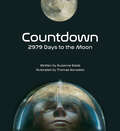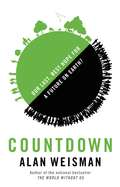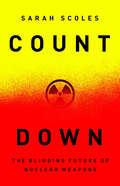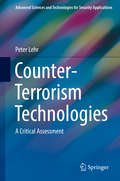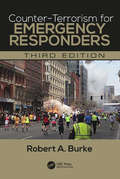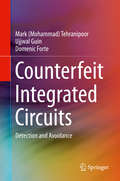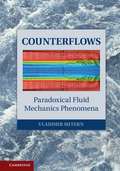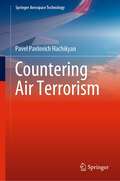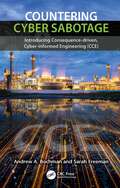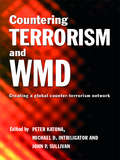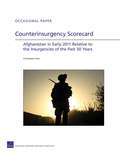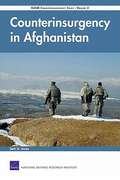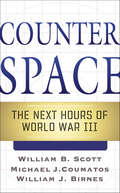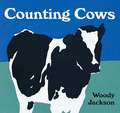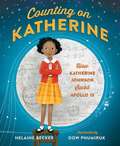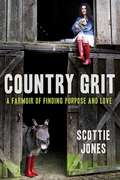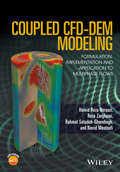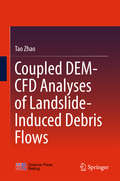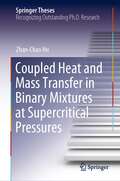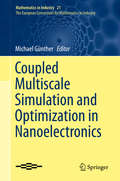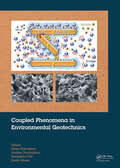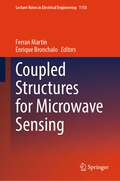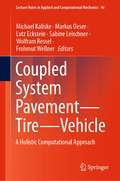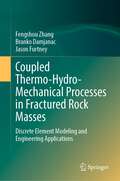- Table View
- List View
Countdown: 2979 Days to the Moon
by Suzanne SladeThe captivating true story of NASA's effort to land the first man on the Moon is told through powerful free verse and stunning illustrations. An inspiring testament to American grit, teamwork, and ingenuity, Countdown presents exhilarating, informative, and accessible free verse by award-winning author Suzanne Slade paired with historic photographs and detailed illustrations by New York Times best-selling illustrator Thomas Gonzalez. Together, they capture the gripping historic story of NASA's twentieth century efforts to conquer a new space frontier. Through triumph and tragedy, success and failure, an entire nation is glued to the high-stakes, 2,979-day mission as eighteen astronauts climb into spacecraft; three men die before even leaving the ground; eight rockets soar into space; and four hundred thousand people―engineers, technicians, scientists, mathematicians, and machinists―join Project Apollo in pursuit of making a dream a reality.
Countdown: Our Last, Best Hope for a Future on Earth?
by Alan WeismanA powerful investigation into the chances for humanity's future from the author of the bestseller The World Without Us.In his bestselling book The World Without Us, Alan Weisman considered how the Earth could heal and even refill empty niches if relieved of humanity's constant pressures. Behind that groundbreaking thought experiment was his hope that we would be inspired to find a way to add humans back to this vision of a restored, healthy planet-only in harmony, not mortal combat, with the rest of nature.But with a million more of us every 4¿ days on a planet that's not getting any bigger, and with our exhaust overheating the atmosphere and altering the chemistry of the oceans, prospects for a sustainable human future seem ever more in doubt. For this long awaited follow-up book, Weisman traveled to more than 20 countries to ask what experts agreed were probably the most important questions on Earth--and also the hardest: How many humans can the planet hold without capsizing? How robust must the Earth's ecosystem be to assure our continued existence? Can we know which other species are essential to our survival? And, how might we actually arrive at a stable, optimum population, and design an economy to allow genuine prosperity without endless growth?Weisman visits an extraordinary range of the world's cultures, religions, nationalities, tribes, and political systems to learn what in their beliefs, histories, liturgies, or current circumstances might suggest that sometimes it's in their own best interest to limit their growth. The result is a landmark work of reporting: devastating, urgent, and, ultimately, deeply hopeful.By vividly detailing the burgeoning effects of our cumulative presence, Countdown reveals what may be the fastest, most acceptable, practical, and affordable way of returning our planet and our presence on it to balance. Weisman again shows that he is one of the most provocative journalists at work today, with a book whose message is so compelling that it will change how we see our lives and our destiny.
Countdown: The Blinding Future of Nuclear Weapons
by Sarah ScolesFor fans of Oppenheimer, a riveting investigation into the modern nuclear weapons landscape. Nuclear weapons are, today, as important as they were during the Cold War, and some experts say we could be as close to a nuclear catastrophe now as we were at the height of that conflict. Despite that, conversations about these bombs generally often happen in past tense. In Countdown, science journalist Sarah Scoles uncovers a different atomic reality: the nuclear age&’s present. Drawing from years of on-the-ground reporting at the nation's nuclear weapons labs, Scoles interrogates the idea that having nuclear weapons keeps us safe, deterring attacks and preventing radioactive warfare. She deftly assesses the existing nuclear apparatus in the United States, taking readers beyond the news headlines and policy-speak to reveal the state of nuclear-weapons technology, as well as how people currently working within the U.S. nuclear weapons complex have come to think about these bombs and the idea that someone, someday, might use them. Through a sharp, surprising, and undoubtedly urgent narrative, Scoles brings us out of the Cold War and into the twenty-first century, opening readers' eyes to the true nature of nuclear weapons and their caretakers while also giving us the context necessary to understand the consequences of their existence, for worse and for better, for now and for the future.
Counter-Terrorism Technologies: A Critical Assessment (Advanced Sciences and Technologies for Security Applications)
by Peter LehrThis book critically discusses the role of technology for counter-terrorism in general, and for securing our vulnerable open societies in particular. It is set against the backdrop of the terrorist threat posed by the combined forces of Al Qaeda and ISIS/Daesh in the foreseeable future. The book commences by illuminating current and foreseeable tactics and weapons used by these implacable enemies – weapons that may well include chemical, biological, radiological and potentially even nuclear (CBRN) devices. In a second part, it introduces technologies already available or in development that promise an increase in safety and security when it comes to the dangers posed by these terrorists. This part also includes a critical discussion of advantages and disadvantages of such technologies that are, quite often, sold as a ‘silver bullet’ approach in the fight against terrorism. Controversies such as those triggered by the abuse of millimeter wave scanners deployed at several Western European airports will demonstrate that there are costs involved with regard to human rights. The third, analytical part takes the critical discussion further by arguing that the uncritical fielding of new surveillance and control technologies in parallel with the on-going outsourcing and privatization of key services of the state could well lead to dystopias as envisaged in a rather prescient way by the so-called cyperpunk novels of the 1980s. The book concludes with the question that any liberal democracy should ask itself: how far can we go with regard to hardening our societies against terrorist threats?
Counter-Terrorism for Emergency Responders
by Robert A. BurkeUsing the authors many years of experience in emergency services and his skills as a hazardous materials consultant, prepares the first responder to handle everything from re-establishing control and on-scene triage to investigating the crime. Including information on pre-incident and avoidance tactics, the author also discusses monitoring and detection techniques, protective equipment and decontamination, and an extensive list of resource organizations and training opportunities. This up-to-date 3rd edition is written to provide concise information for emergency responders who might be called upon to confront explosive, chemical, nuclear, biological, or incendiary acts of terrorism.
Counterfeit Integrated Circuits: Detection and Avoidance
by Mark Mohammad Tehranipoor Ujjwal Guin Domenic ForteThis timely and exhaustive study offers a much-needed examination of the scope and consequences of the electronic counterfeit trade. The authors describe a variety of shortcomings and vulnerabilities in the electronic component supply chain, which can result in counterfeit integrated circuits (ICs). Not only does this book provide an assessment of the current counterfeiting problems facing both the public and private sectors, it also offers practical, real-world solutions for combatting this substantial threat. #65533; Helps beginners and practitioners in the field by providing a comprehensive background on the counterfeiting problem; #65533; Presents innovative taxonomies for counterfeit types, test methods, and counterfeit defects, which allows for a detailed analysis of counterfeiting and its mitigation; #65533; Provides step-by-step solutions for detecting different types of counterfeit ICs; #65533; Offers pragmatic and practice-oriented, realistic solutions to counterfeit IC detection and avoidance, for industry and government.
Counterflows
by Vladimir ShternThis book discusses the physical mechanisms that drive counterflows, examining how they emerge, develop, become double and multiple counterflows and comprise both global and local circulations. Counterflows play an important role in nature and technology. A natural example is the Gulf Stream and the opposite flow in the ocean depths. Technological applications include hydrocyclones, vortex tubes and vortex combustors. These elongated counterflows are wildly turbulent but survive intense mixing, a seeming paradox. Local counterflows, whose spatial extent is small compared with that of surrounding flows, occur behind bluff bodies and in swirling streams. The latter are often referred to as vortex breakdown bubbles, which occur in tornadoes and above delta wings. Most scale counterflows are cosmic bipolar jets. Most miniature counterflows occur in capillary menisci of electrosprays and fuel atomisers.
Countering Air Terrorism (Springer Aerospace Technology)
by Pavel Pavlovich HachikyanThis book examines the issues of ensuring anti-terrorist security of an aviation enterprise, provides a history of terrorism in the aviation sector, and analyzes the legal regulations. This book provides mathematical and mathematical–psychological models for reducing the risk of terrorist threats, which makes it possible to objectively increase the safety of air transport facilities, reduce the likelihood of terrorist attacks, save human lives and prevent significant material losses. The solutions of general humanistic problems proposed in the book—preventing accidents and preserving the world—are an original feature of the book, which allows one to treat it with the necessary attention and interest for the reader. The concept of anti-terrorist security of an aviation enterprise presented in this book has been widely tested and introduced into the activities of leading aviation enterprises, including the Interstate Aviation Committee (IAC), and has been used in the investigation of aviation accidents. This book is written for a wide range of audience associated with ensuring aviation transport security and for the end users of airlines—passengers, in order to expand their knowledge about the reliability of using air transport.
Countering Cyber Sabotage: Introducing Consequence-Driven, Cyber-Informed Engineering (CCE)
by Sarah Freeman Andrew A. BochmanCountering Cyber Sabotage: Introducing Consequence-Driven, Cyber-Informed Engineering (CCE) introduces a new methodology to help critical infrastructure owners, operators and their security practitioners make demonstrable improvements in securing their most important functions and processes. Current best practice approaches to cyber defense struggle to stop targeted attackers from creating potentially catastrophic results. From a national security perspective, it is not just the damage to the military, the economy, or essential critical infrastructure companies that is a concern. It is the cumulative, downstream effects from potential regional blackouts, military mission kills, transportation stoppages, water delivery or treatment issues, and so on. CCE is a validation that engineering first principles can be applied to the most important cybersecurity challenges and in so doing, protect organizations in ways current approaches do not. The most pressing threat is cyber-enabled sabotage, and CCE begins with the assumption that well-resourced, adaptive adversaries are already in and have been for some time, undetected and perhaps undetectable. Chapter 1 recaps the current and near-future states of digital technologies in critical infrastructure and the implications of our near-total dependence on them. Chapters 2 and 3 describe the origins of the methodology and set the stage for the more in-depth examination that follows. Chapter 4 describes how to prepare for an engagement, and chapters 5-8 address each of the four phases. The CCE phase chapters take the reader on a more granular walkthrough of the methodology with examples from the field, phase objectives, and the steps to take in each phase. Concluding chapter 9 covers training options and looks towards a future where these concepts are scaled more broadly.
Countering Terrorism and WMD: Creating a Global Counter-Terrorism Network (Political Violence)
by Peter Katona Michael D. Intriligator John P. SullivanThis volume shows us that in order to deal with today’s Fourth Generation asymmetric warfare by terrorist groups using conventional arms and weapons of mass destruction, we need a new ‘global networked’ approach. The contributors examine the various attempts that have been made to counter the latest wave of terrorism, including the US strikes against Afghanistan and Iraq, President George W. Bush's declaration of a ‘war against terrorism’, the creation of the US Department of Homeland Security, and the 9/11 Commission. Drawing from our experience with ‘Terrorism Early Warning’ and the co-production of counter-terrorism intelligence, this book explains the need for such a network and shows how it could be formed. It compiles the opinions of experts from clinical medicine, public policy, law enforcement and the military. These expert contributors identify the nature of a global counter-terrorism network, show how it could be created, and provide clear guidelines for gauging its future effectiveness. This book will be of great interest to all students of terrorism studies, US national security, international relations, and political science in general.
Counterinsurgency Scorecard: Afghanistan In Early 2011 Relative to the Insurgencies of the Past 30 Years
by Christopher PaulA core finding of previous RAND research on 30 years of insurgencies worldwide was that a conflict's overall score on a scorecard of 15 equally weighted good and 12 equally weighted bad counterinsurgency factors and practices perfectly predicted the ultimate outcome. Using the scorecard approach and an expert elicitation (Delphi) exercise, a RAND project sought to extend the findings to the case of Afghanistan in early 2011.
Counterinsurgency in Afghanistan: Rand Counterinsurgency Study
by Seth G. JonesThis study explores the nature of the insurgency in Afghanistan, the key challenges and successes of the U.S.-led counterinsurgency campaign, and the capabilities necessary to wage effective counterinsurgency operations. By examining the key lessons from all insurgencies since World War II, it finds that most policymakers repeatedly underestimate the importance of indigenous actors to counterinsurgency efforts. The U.S. should focus its resources on helping improve the capacity of the indigenous government and indigenous security forces to wage counterinsurgency. It has not always done this well. The U.S. military-along with U.S. civilian agencies and other coalition partners-is more likely to be successful in counterinsurgency warfare the more capable and legitimate the indigenous security forces (especially the police), the better the governance capacity of the local state, and the less external support that insurgents receive.
Counterinsurgency in Modern Warfare
by Daniel Marston Carter MalkasianThrough history armies of occupation and civil power have been repeatedly faced with the challenges of insurgency. US involvement in Iraq and Afghanistan has highlighted this form of conflict in the modern world. Armies, sometimes reluctantly, have had to adopt new doctrines and tactics to deal with the problems of insurgency and diverse counterinsurgency strategies have been developed. These have ranged from conventional military operations to a combination of military and political strategy including propaganda, Psy-Ops, and other approaches. In Counterinsurgency in Modern Warfare 13 contributors examine developments in counterinsurgency from the early 20th century to the present. Each author, an expert in his field, discusses in depth the conduct and outcomes of operations across the globe, including the Arab-Israeli conflict, Afghanistan and Iraq, and draws out the lessons to be learned from them. This book is a timely, serious yet accessible survey of a critical facet of modern warfare and present-day global conflict.
Counterspace: The Next Hours of World War III
by William J. Birnes William B. Scott Michael J. Coumatos“Takes us to the front lines of the space- and cyber-security world. A must-read to preview how our national-security future will unfold!” —Gen. Richard B. Myers (USAF-Ret.), former Chairman, Joint Chiefs of StaffIn Space Wars, Scott, Coumatos, and Birnes created a fascinating war gaming scenario of how World War III might unfold above the Earth’s surface. Now this thrilling team of writers reunites with Counterspace, an even more chilling fictionalized look at America’s most catastrophic fears.What if North Korea detonated a nuclear weapon in space and silenced dozens of satellites?What if an Iranian missile threatened to destroy Israel, while a Venezuelan “research” satellite endangered one of the US’s most promising space initiatives?What if tech-savvy terrorist cells unleashed back-to-back horrors in California, creating an avalanche of crises overnight, as national leaders robbed of spy satellite imagery were forced to make decisions in the “blind?”These are the scenarios of Counterspace, a frighteningly plausible look at threats to the United States and the world. Scott, Coumatos, and Birnes use war gaming scenarios to show how the US Strategic Command might choose to fight off these menaces and prevent global disaster. Combining current and future technology with our enemies’ grandest plans, Counterspace is equally a terrifying possibility and a hopeful affirmation that America can and will be ready to face such dangers, told with the pulse-pounding power of a modern-day thriller.“A page-turning techno-thriller . . . the story reads like today’s headlines, faithfully taking the reader inside the minds of madmen, heroes and space warriors.” —Elliot Holokauahi Pulham, Chief Executive Officer, The Space Foundation
Counting Cows
by Woody JacksonCows munch, meander, sleep, sun themselves, and wade through vibrant Vermont landscapes before gathering for a kick-up-your-hooves barn dance. This bold, bovine twist on counting is sure to amuse little ones just learning their numbers.
Counting on Katherine: How Katherine Johnson Saved Apollo 13
by Helaine BeckerThe story of Katherine Johnson whose contributions were crucial to the America's space program.
Country Grit: A Farmoir of Finding Purpose and Love
by Scottie JonesScottie Jones lived a typical suburban, professional life in Phoenix until her husband, Greg, got into a near-fatal car accident. While recovering, he became convinced that they needed a change and a simpler way of life, one more connected with nature and with each other. So, driven by a desire to cut ties with a material and convenient suburban life that had left them feeling empty, they bought a peaceful-looking farmhouse on sixty acres in Oregon and said good-bye to everything they knew. But though the grass may look greener, the road to pastoral bliss is fraught with financial woes, relentless rural roadblocks, and colossal failures. When the burden becomes almost too much to bear, Scottie hits on the idea of turning a house they initially built for their daughter into a Farm Stay, where people could visit and learn about Leaping Lamb Farm. The Farm Stay becomes the niche that rescues them from foreclosure—having found both a sense of purpose and a sense of place, the couple now finds the means to sustain it. In a world increasingly filled with questions of where our food comes from and dissatisfactions about our modern lives, Country Grit is a story that will resonate with countless people itching to get back to the land. Told with humor and hard-earned wisdom, it is also an account of what small-scale farmers across the country experience everyday and a warning that the farming life is not for everyone.
Coupled CFD-DEM Modeling: Formulation, Implementation and Application to Multiphase Flows
by Hamid Reza Norouzi Navid Mostoufi Rahmat Sotudeh-Gharebagh Reza ZarghamiDiscusses the CFD-DEM method of modeling which combines both the Discrete Element Method and Computational Fluid Dynamics to simulate fluid-particle interactions. Deals with both theoretical and practical concepts of CFD-DEM, its numerical implementation accompanied by a hands-on numerical code in FORTRAN Gives examples of industrial applications
Coupled DEM-CFD Analyses of Landslide-Induced Debris Flows (Springer Tracts in Civil Engineering)
by Tao ZhaoThis book reflects the latest research results in computer modelling of landslide-induced debris flows. The book establishes an understanding of the initiation and propagation mechanisms of landslides by means of numerical simulations, so that mitigation strategies to reduce the long-term losses from landslide hazards can be devised. In this context, the book employs the Discrete Element Method (DEM) and Computational Fluid Dynamics (CFD) to investigate the mechanical and hydraulic behaviour of granular materials involved in landslides - an approach that yields meaningful insights into the flow mechanisms, concerning e. g. the mobilization of sediments, the generation and dissipation of excess pore water pressures, and the evolution of effective stresses. As such, the book provides valuable information, useful methods and robust numerical tools that can be successfully applied in the field of debris flow research.
Coupled Heat and Mass Transfer in Binary Mixtures at Supercritical Pressures (Springer Theses)
by Zhan-Chao HuSupercritical pressure fluids have been exploited in many engineering fields, where binary mixtures are frequently encountered. This book focuses on the coupled heat and mass transfer in them, where the coupling comes from cross-diffusion effects (i.e., Soret and Dufour effects) and temperature-dependent boundary reactions. Under this configuration, three main topics are discussed: relaxation and diffusion problems, hydrodynamic stability, and convective heat and mass transfer. This book reports a series of new phenomena, novel mechanisms, and an innovative engineering design in hydrodynamics and transport phenomena of binary mixtures at supercritical pressures. This book covers not only current research progress but also basic knowledge and background. It is very friendly to readers new to this field, especially graduate students without a deep theoretical background.
Coupled Multiscale Simulation and Optimization in Nanoelectronics (Mathematics in Industry #21)
by Michael GüntherDesigning complex integrated circuits relies heavily on mathematical methods and calls for suitable simulation and optimization tools. The current design approach involves simulations and optimizations in different physical domains (device, circuit, thermal, electromagnetic) and in a range of electrical engineering disciplines (logic, timing, power, crosstalk, signal integrity, system functionality). COMSON was a Marie Curie Research Training Network created to meet these new scientific and training challenges by (a) developing new descriptive models that take these mutual dependencies into account, (b) combining these models with existing circuit descriptions in new simulation strategies and (c) developing new optimization techniques that will accommodate new designs. The book presents the main project results in the fields of PDAE modeling and simulation, model order reduction techniques and optimization, based on merging the know-how of three major European semiconductor companies with the combined expertise of university groups specialized in developing suitable mathematical models, numerical schemes and e-learning facilities. In addition, a common Demonstrator Platform for testing mathematical methods and approaches was created to assess whether they are capable of addressing the industry's problems, and to educate young researchers by providing hands-on experience with state-of-the-art problems.
Coupled Phenomena in Environmental Geotechnics
by Sebastiano Foti Mario Manassero Andrea Dominijanni Guido MussoEnvironmental Geotechnics deals with a wide variety of applications, such as the characterization of polluted sites and landfill waste, the design of containment systems for subsoil pollutant control, radioactive waste disposal, geo-energy exploitation and bacteria-driven soil modification, among others. Reliable and effective predictions of the ac
Coupled Structures for Microwave Sensing (Lecture Notes in Electrical Engineering #1150)
by Ferran Martín Enrique BronchaloThis book offers a comprehensive and timely review of planar microwave sensors based on coupled structures. Gathering chapters contributed by the most authoritative researchers on this topic, it presents various strategies for sensor performance optimization using coupled lines, directional couplers, and coupled resonators (either distributed or semi-lumped), focusing mainly on sensitivity optimization, and covering chains of coupled resonators as well. The book also reports on analytical methods, design formulas, sensor validation tests, with both simulation and experimental methods, describing some relevant practical applications. Mainly reflecting the research activity carried out by the different contributors in the last years, this book also includes two introductory chapters to help readers who are not very familiar with microwave sensing technologies and coupled structures. All in all, this book addresses advanced graduate students and researchers involved in microwave and sensor technologies, and may be of interest for engineers and professionals as well, working in areas as diverse as wireless sensors and sensor networks, biosensing, chemical sensing, motion control, microfluidics, Internet of Things (IoT), and smart systems.
Coupled System Pavement - Tire - Vehicle: A Holistic Computational Approach (Lecture Notes in Applied and Computational Mechanics #96)
by Michael Kaliske Markus Oeser Lutz Eckstein Sabine Leischner Wolfram Ressel Frohmut WellnerThis book summarizes research being pursued within the Research Unit FOR 2089, funded by the German Research Foundation (DFG), the goal of which is to develop the scientific base for a paradigm shift towards dimensioning, structural realization and maintenance of pavements, and prepare road infrastructure for future requirements. It provides a coupled thermo-mechanical model for a holistic physical analysis of the pavement-tire-vehicle system: based on this model, pavement structures and materials can be optimized so that new demands become compatible with the main goal – durability of the structures and the materials. The development of these new and qualitatively improved modelling approaches requires a holistic procedure through the coupling of theoretical numerical and experimental approaches as well as an interdisciplinary and closely linked handling of the coupled pavement-tire-vehicle system. This interdisciplinary research provides a deeper understanding of the physics of the full system through complex, coupled simulation approaches and progress in terms of improved and, therefore, more durable and sustainable structures.
Coupled Thermo-Hydro-Mechanical Processes in Fractured Rock Masses: Discrete Element Modeling and Engineering Applications
by Fengshou Zhang Branko Damjanac Jason FurtneyThe subject of thermo-hydro-mechanical coupled processes in fractured rock masses has close relevance to energy-related deep earth engineering activities, such as enhanced geothermal systems, geological disposal of radioactive waste, sequestration of CO2, long-term disposal of waste water and recovery of hydrocarbons from unconventional reservoirs. Despite great efforts by engineers and researchers, comprehensive understanding of the thermo-hydro-mechanical coupled processes in fractured rock mass remains a great challenge. The discrete element method (DEM), originally developed by Dr. Peter Cundall, has become widely used for the modeling of a rock mass, including its deformation, damage, fracturing and stability. DEM modeling of the coupled thermo-hydro-mechanical processes in fractured rock masses can provide some unique insights, to say the least, for better understanding of those complex issues.The authors of this book have participated in various projects involving DEM modeling of coupled thermo-hydro-mechanical processes during treatment of a rock mass by fluid injection and/or extraction and have provided consulting services to some of the largest oil-and-gas companies in the world. The breadth and depth of our engineering expertise are reflected by its successful applications in the major unconventional plays in the world, including Permian, Marcellus, Bakken, Eagle Ford, Horn River, Chicontepec, Sichuan, Ordos and many more. The unique combination of the state-of-the-art numerical modeling techniques with state-of-the-practice engineering applications makes the presented material relevant and valuable for engineering practice. We believe that it is beneficial to share the advances on this subject and promote some further development.
